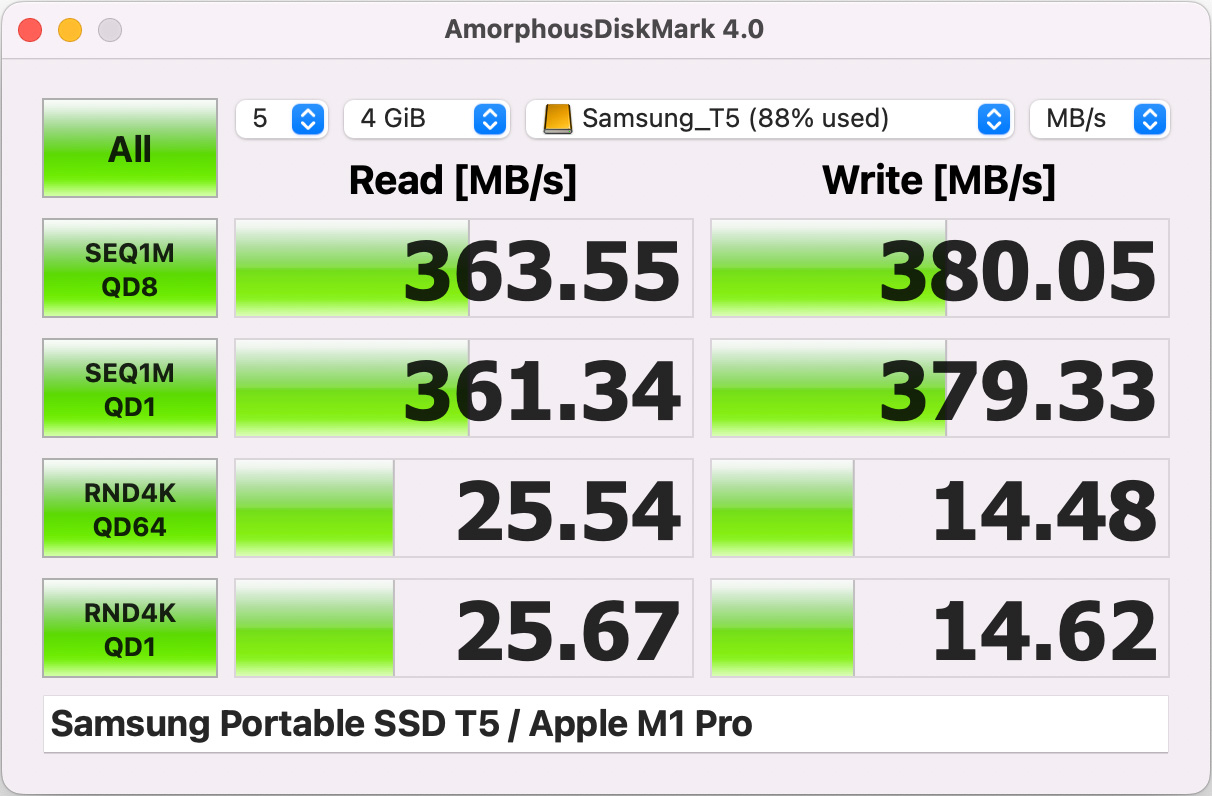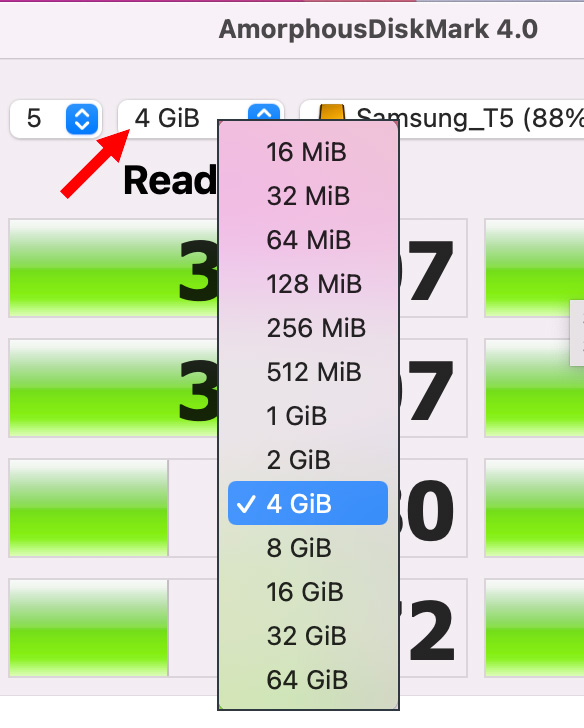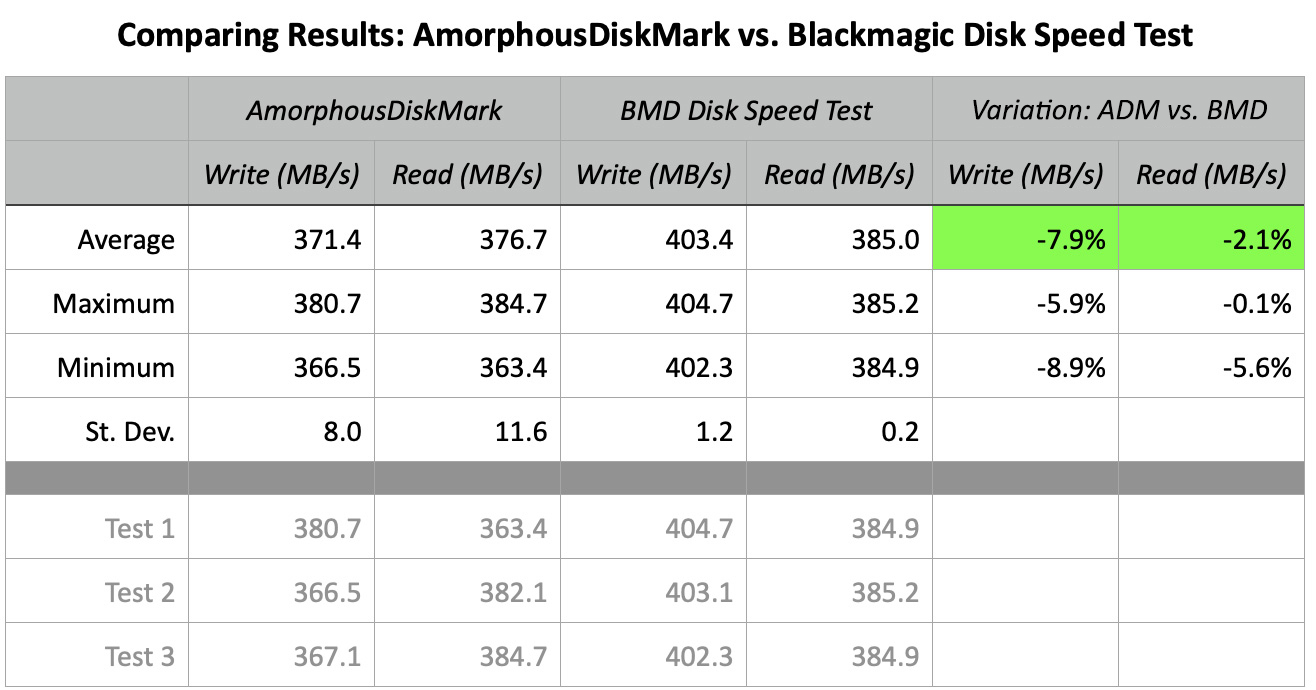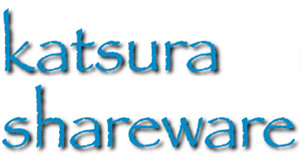 UPDATE (Dec. 15, 2022,): Measuring storage speeds using MiB and GiB, instead of MB and GB, can result in over-stating storage speed by up to 8%. This can be compensated for in how the code is written, but there’s no way – from the outside – to tell if this correction is being made.
UPDATE (Dec. 15, 2022,): Measuring storage speeds using MiB and GiB, instead of MB and GB, can result in over-stating storage speed by up to 8%. This can be compensated for in how the code is written, but there’s no way – from the outside – to tell if this correction is being made.
After reading my recent commentary about at the speed differences between Blackmagic Disk Speed Test and AJA System Test Lite, Lee suggested I look into AmorphousDiskMark, a Mac utility from Katsura Software.
This free utility measures the speed of Mac-connected storage in both MB/second and IOPs. It joins Blackmagic Design Disk Speed test, AJA System Test Lite, and Activity Monitor in helping us determine if our storage is fast enough to handle the media we need to process.
NOTE: MB/second is more appropriate for media creators because it measures how quickly files will transfer between storage and the computer. IOPs (input/output operations per second) are more relevant for database or office operations which write or read smaller chunks of data.
Katsura Shareware was founded in 2004 to “create shareware that makes your Mac more useful and fun to use.” So far, they’ve published 16 different utilities.
EXECUTIVE SUMMARY

AmorphousDiskMark was released in January, 2022, and requires macOS 10.9.5 or later. I’m running these tests on an M1 MacBook Pro and testing a Samsung T5 PCIe SSD.

This simple-to-use utility analyzes storage performance two ways: sequential read/write (typical for media creators) and random access (typical for database and small file operations). Media creators should pay attention to the top two lines in the on-screen report and ignore the bottom two.
Running a complete test takes about five minutes and yields results similar to, but slightly lower than, Blackmagic Disk Speed Test.
What I like about this test is that it provides more detailed results that are applicable to a larger range of users (media creators, database administrators and IT specialists). The only downside is that you need to know which results apply to you and ignore those that don’t.
If you want a detailed look as how fast your storage is, AmorphousDiskMark 4.0 provides a fast – and free – way to analyze your storage in depth.
Product: AmorphousDiskMark
Developer: Katsura Shareware
Website: https://katsurashareware.com/amorphousdiskmark/
Mac App Store: https://apps.apple.com/us/app/amorphousdiskmark/id1168254295?mt=12
Price: Free
INSTALLATION
AmorphousDiskMark is available from the Mac App Store. Installation is trivial and works just as you would expect.
TESTING SPEEDS

After starting the application, select the storage you want to test from the popup menu at the top.
NOTE: Unlike hard drives, SSDs don’t change speed as they fill up.

Next, determine the size of the test file. Testing for databases or office files should pick a small file size, around 64 MiB. Media creators should pick a larger file, around 4 GiB. Larger files always transfer faster.
NOTE: MiB and GiB are marketing labels that define a megabyte as 1,000 KB and a gigabyte as 1,000 MB. Computers actually format data as powers of 2, so an MB is 1,024 KB while a GB is 1,024 MB. Measuring data rates using MiB vs. MB will affect reported speeds with MiB up to 8% faster.
You can also set the number of tests, but the default setting of 5 is fine.

To run all four tests, click the All button at the top. However, the last two tests are not generally needed for media creators, so, to save wear and tear on your storage, you don’t need to run these. Just click the buttons indicated by the red arrows.
Most of the time, I pay attention to the top line.


Comparing AmorphousDiskMark with Blackmagic Disk Speed Test shows variations in speed, so let’s look a bit deeper into those variations.
NOTE: Read and write results are reversed between these two tests. Make sure you are looking in the correct column before comparing numbers. Again, I would compare the top line numbers.
DETAILED RESULTS

This table compares the speed of AmorphousDiskMark 4.0 to Blackmagic Disk Speed Test by running three tests each, then averaging the results. As you can see looking at the green fields in this table, write speeds were reported about 8% slower, on average, and read speeds were reported about 2% slower.
UPDATE NOTE: However, there is debate currently on the accuracy of Blackmagic Disk Speed Test. We are currently unable to tell which software is more accurate.
The Standard Deviation shows the variations between these tests. The closer standard deviation gets to zero, the less the variation. BMD delivers extremely consistent results, while AmorphousDiskMark varies a bit more.
However, consistency does not necessarily mean accuracy.
SUMMARY
 I wouldn’t obsess too much over test result variability, provided that tool is essentially accurate. Once you find a tool you are comfortable using, use it consistently.
I wouldn’t obsess too much over test result variability, provided that tool is essentially accurate. Once you find a tool you are comfortable using, use it consistently.
AmorphousDiskMark is another tool we can use to measure storage speeds. It provides more details that are meaningful to a wider range of users. Media creators should just use the top line test in most instances.
UPDATE NOTE: However, given the seeming inaccuracy of all speed measurement tools, and the fact that AmorphousDiskMark uses MiB and GiB to define test file size, it is impossible to say whether this software is accurate.
What I like about AmorphousDiskMark is the range of tests it provides, the level of customization we can apply to those tests and the simplicity of its interface. If you are looking for a measurement tool to add to your collection, consider adding AmorphousDiskMark 4.0
3 Responses to Review: AmorphousDiskMark 4.0 from Katsura Software [u]
Hi Larry,
Yet another tool that measures disk speeds as well as system wide monitoring is Istats menus
https://bjango.com/mac/istatmenus/
I’d be interested to see how you think this compares to other disk speed monitors you’ve reviewed recently
Rob:
The problem is that we don’t know which, if any, software is accurate. We know that AJA System Test Lite is NOT accurate, according to AJA. However, there is still a WIDE divergence between BMD and AJA software. If we don’t know what is right, how can we judge ANY software? Even Activity Monitor is reported to be inaccurate.
Maybe Bjango is perfect. Bu there’s no way to know. It is very frustrating. I’ve looked at StatMenus in the past and been impressed. But as for accuracy? That’s impossible to answer.
Sigh.
Larry
[…] It turns out the choice of adapter makes a big difference, so I would recommend in performance order from best to worst, but the main thing is don't believe the specs, you really have to test it with AmorphousDiskMark: […]